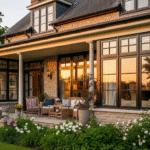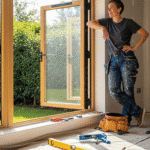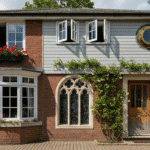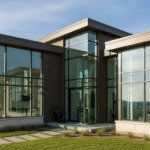Thinking about new windows? The right style can boost curb appeal, cut energy bills, quiet outside noise, and make rooms feel bigger and brighter. This guide walks you through every major decision—from materials and glass to style-by-style pros and cons—so you can choose with confidence.
Quick checklist (what to decide)
Goal: Energy savings, more light, ventilation, noise control, security, or a facelift?
Opening size & code: Rough opening, egress needs (bedrooms), tempered glass near doors/tubs.
Climate: Pick the right U-Factor and SHGC for your region.
Operation & airflow: How you want windows to open and clean.
Style of home: Match architecture and sightlines.
Maintenance: Paint-free vs. stainable wood interior; tilt-in for easy cleaning.
Budget & ROI: Frame material, glass package, hardware, and custom colors affect price.
Window styles, explained (with pros, cons & best uses)
1) Double-Hung
Two sashes slide up and down; both can tilt in for cleaning.
Best for: Traditional homes, bedrooms, multi-story exteriors.
Pros: Classic look, great ventilation (top + bottom), easy cleaning.
Cons: More air leakage than casements; smaller clear opening vs. sliders.
2) Single-Hung
Top sash fixed; bottom sash moves.
Best for: Lower budgets, simple openings.
Pros: Cost-effective, fewer moving parts.
Cons: Less airflow; cleaning top exterior is harder upstairs.
3) Casement
Side-hinged; crank opens like a door.
Best for: Max energy efficiency and airflow; modern or cottage styles.
Pros: Tight seal, excellent ventilation, great for hard-to-reach places (over sinks).
Cons: Clearance needed outside; cranks/hardware add cost.
4) Awning
Top-hinged; opens outward from the bottom.
Best for: Bathrooms, rain-friendly ventilation, high placements.
Pros: Can vent in light rain; good privacy + airflow.
Cons: Requires exterior clearance; limited view height.
5) Slider (Glider)
One sash slides horizontally.
Best for: Wide openings, contemporary looks, patios.
Pros: Big, uninterrupted views; simple operation; economical.
Cons: Tracks need occasional cleaning; slightly higher air leakage than casement.
6) Picture (Fixed)
Doesn’t open.
Best for: Big views, accent windows, energy efficiency.
Pros: Highest efficiency; broad daylight; minimal maintenance.
Cons: No ventilation; must pair with operable units nearby.
7) Bay & Bow
Projection windows—bay (3 panels), bow (4–6 panels).
Best for: Statement curb appeal, reading nooks, dining areas.
Pros: Enlarges feel of room; adds dimension and light.
Cons: Higher cost; structural support and roofing details required.
8) Garden
Shallow greenhouse box with glass sides/top.
Best for: Kitchen herbs or display.
Pros: Natural light shelf; unique look.
Cons: Heat gain; weight/support considerations.
9) Specialty Shapes (Arched, Circle, Hex, Trapezoid)
Best for: High gables, stairwells, custom designs.
Pros: Dramatic architecture; pairs well with operable units.
Cons: Usually fixed or limited operation; custom pricing.
Match style to room goals
| Room/Need | Best Picks | Why |
|---|---|---|
| Kitchen (over sink) | Casement, Awning | Easy reach; great venting |
| Living/Great room | Picture + Casement/Slider flanks | Big views + controlled airflow |
| Bedrooms | Double-Hung, Casement | Egress compliant; quiet & efficient |
| Bathrooms | Awning, Casement (obscure glass) | Privacy + moisture control |
| Hall/Stair | Picture, Specialty Shapes | Light & drama without drafts |
| Patio/Deck wall | Large Slider or Multi-Slide | Wide opening, indoor-outdoor feel |
Frame materials: performance, look, upkeep
Vinyl: Great value/efficiency; low maintenance; many colors (dark exteriors may need heat-reflective formulas).
Fiberglass/Composite: Strong, slim profiles; excellent thermal stability; paintable exteriors.
Wood (clad): Warm interior; exterior aluminum/fiberglass cladding for low upkeep; premium price.
Aluminum (thermal break): Slim sightlines; durable; typically used in warm climates or modern builds; can be less efficient without top glass packages.
Tip: For dark modern looks, compare factory finishes (baked-on enamel vs. laminate) and warranty terms.
Glass packages: what actually saves energy
Double vs. Triple Pane: Triple is best for cold climates/noise; quality double-pane with Low-E is ideal for most regions.
Low-E Coatings: Reflect heat; pick formulas for your climate (high SHGC in cold, low SHGC in hot/sunny).
Gas Fills: Argon (standard value) or Krypton (thinner gaps/triple-pane).
Warm-Edge Spacers: Reduce condensation and edge heat loss.
Laminated/Acoustic: Better sound control and security; improves STC rating.
Key Ratings (on NFRC label):
U-Factor: Insulation. Lower = better (e.g., 0.20–0.29 for strong performance).
SHGC: Solar heat gain. Lower = blocks more sun (hot climates).
VT (Visible Transmittance): 0–1; higher = more daylight.
AL (Air Leakage): Lower = fewer drafts (≤0.3 is common spec; casements excel here).
Installation types (and why they matter)
Insert/Retrofit: New frame into existing opening/trim. Faster, less disruption, lower cost. Ensure the old frame is sound and square.
Full-Frame/New-Construction: Removes entire unit to studs; new flashing/sill pan; best for rot repair and maximum efficiency, but higher cost.
Pro tip: Ask your installer about sill pans, flashing tape sequence, spray foam type (low-expansion), and interior air-seal details. The install can make or break performance.
Budget planning & ROI
Cost drivers: Size, material, custom colors, hardware, glass options, install complexity, exterior trim.
Phase smart: Do elevations (front/back) or floors together for a consistent look.
Savings: Energy bills, maintenance, and curb appeal roll into long-term ROI. Check local rebates and federal incentives for ENERGY STAR® packages.
Common mistakes to avoid
Choosing style for looks only (ignoring airflow, egress, or cleaning).
Mismatching SHGC to climate (overheats rooms or limits winter warmth).
Underestimating exterior clearance for casements/awnings.
Skipping full-frame when there’s rot or water intrusion.
Mixing finishes across batches causing mismatched sightlines.
Step-by-step: choosing your replacement windows
List goals per room (light, view, airflow, privacy, noise).
Measure openings (width × height, check squareness/rot).
Pick style by use (see matrix above).
Select frame material (efficiency vs. look vs. maintenance).
Choose glass package (Low-E, gas, panes, acoustic/laminated).
Confirm performance numbers (U-Factor/SHGC for your climate).
Decide install type (insert vs. full-frame).
Compare quotes (include warranties, lead times, and install details).
Schedule & prep (clear access, alarm sensors, window treatments).
Inspect & register warranties (and keep receipts for rebates).





